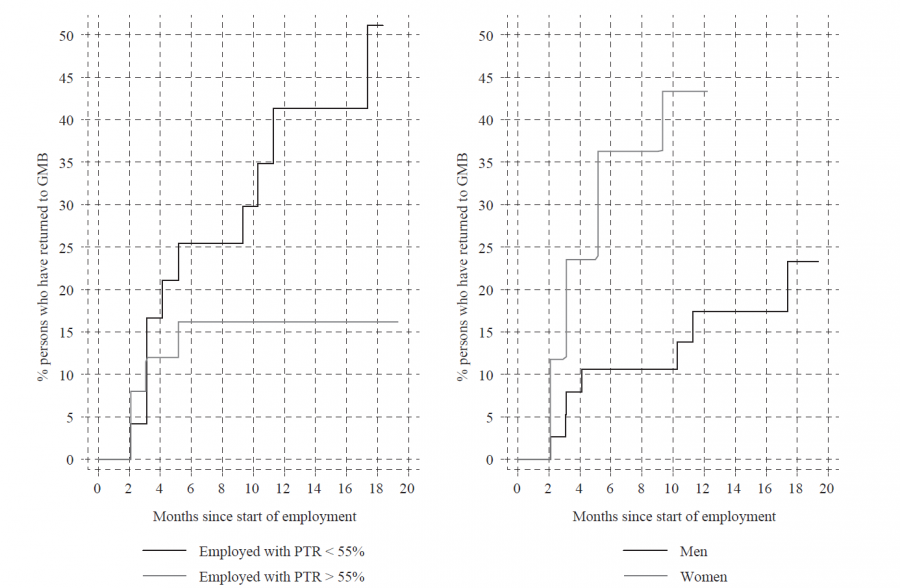1 INTRODUCTION
There are two kinds of income support that unemployed persons in Croatia can access, in line with the continental social security tradition. The first is contribution-based unemployment benefit which is conditional on prior employment (at least 9 months of employment in the last 24 months) and related to the prior earnings of the individual. Unemployment benefit can be received for up to 15 months although most recipients qualify for 3-6 months. Such a conditionality and the limited duration make for a rather patchy coverage of the unemployed (graph 1, grey line), in particular during periods of economic growth, when few long-term employed enter unemployment.
The second support option for an unemployed person is the guaranteed minimum benefit (GMB), a means-tested social assistance benefit granted at the household level. In order to qualify for GMB, citizens who are fit to work must be registered as unemployed and demonstrate efforts at activation. The number of unemployed GMB recipients over the past decade stood at a rather stable level, with oscillations (between 40,000 to 50,000) following the economic cycle. At the end of 2016, there were a total of 47,000 unemployed GMB recipients, which translates to 1.7% of the working-age population, 2.6% of active population (per Labour Force Survey, LFS), or about 19.9% of registered unemployed persons.
While the numbers of beneficiaries are substantial, to date there has been no empirical research on the patterns and challenges of transition to employment in the case of GMB recipients. Since national SILC data are unsuitable for the task1, this paper uses administrative data in order to establish the feasibility of such an effort, while providing basic insights about the incidence of transitions by GMB recipients to employment and the mechanisms involved.
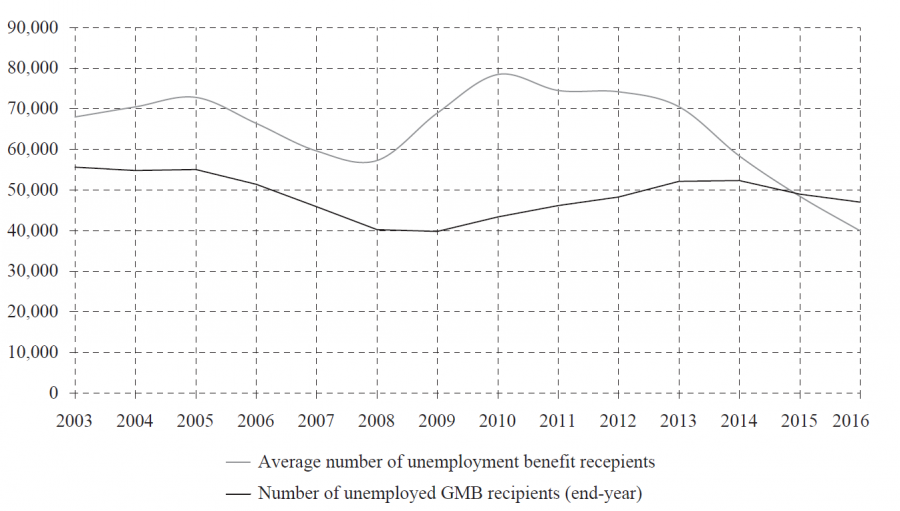
Source: Croatian Employment Service and Ministry of Social Welfare.
The paper is organized as follows. In the second section we discuss the employment barriers involved in welfare-to-work transitions, identifying three distinct theoretical mechanisms. In third section we present our data collection, organization and analytical approach. The fourth section is composed of three parts. In the first we discuss the structure of unemployed GMB recipients, according to criteria identified as relevant in the initial discussion. In the second we observe welfare-to-employment transitions in general, differences between groups relevant for each theoretical mechanism, and estimate a joint Cox proportional hazards model. In the third part we examine outcomes of successful transitions: remuneration, realized PTR and relapse into GMB. In the final section we summarise the findings, discuss limitations and make case for applying this approach to more extensive data collection.
2 THEORETICAL MECHANISMS
We will broadly follow the Employment Barriers approach introduced by the OECD and the World Bank (Fernandez et al., 2016). In individual cases, barriers might emerge from lack of financial incentives or lack of work-related capabilities, each calling for a different set of policy interventions.
Incentives to work might be low due to high non-labour income, but GMB is strictly means-tested and non-labour income of recipients is monitored, so this dimension does not feature as a barrier in the case of GMB recipients. However, the inactivity trap due to a high level of earnings-replacement benefits might act as a barrier. The income criterion that qualifies a household for GMB is lower than the net minimum wage for all but the largest households2, making GMB effectively limited to jobless households, or households with very low (formal) work intensity. Consequently, the first employment of any household member usually leads to withdrawal of GMB for the entire household (or a household member leaving the household). While household benefit level is capped at the level of a single gross minimum wage (HRK 3,276 in 2017), in most cases GMB is supplemented by other benefits that use GMB as prerequisite3. Those additional benefits are all withdrawn if household income exceeds the GMB qualification threshold. Such a setup leads to an “inactivity trap” in which unemployed persons with low earnings potential and receiving benefits face a situation where taking up employment may lead to little (or no) increase in disposable income as a result of the combined effects of benefit withdrawal and higher tax burdens on in-work earnings (Carone et al., 2004). In other words, for households in the inactivity trap, work does not pay off. The inactivity trap is characterised by a very high marginal effective tax rate (METR), which is effectively the participation tax rate (PTR) in cases when starting work-based income equals zero (Jara Tamayo, Gasior and Makovec, 2017). The level of PTR is strongly associated with social security setup, household structure and earning potential. In Croatia,Bejaković, Urban and Bezeredi (2013) have identified that transition from inactivity to single-earner minimum-wage bears PTR above 100% for individuals from jobless households with dependent children and single-parent households. Similar inactivity trap estimates for such individuals are published by the EU Tax and Benefits Indicator Database (EU-TBID), at 102% and 110% respectively. For a single person household or two-adult household PTR for such a transition is still substantial but lower (63% and 72%), primarily due to GMB being far lower than the minimum wage. This leads us to expect that unemployed GMB recipients from households with dependent children and single-parent households would face greater PTR, and thus have lower economic incentives to make the transition to employment.
Lack of work-related capabilities makes for another set of barriers to employment (Fernandez et al., 2016) that hinder access of GMB recipients to the labour market. In particular, the role of human capital, drawn either from education or work experience is crucial to understanding employability. Level of human capital has been consistently identified as the strongest predictors of career progression (Fugate, Kinicki and Ashforth, 2004), confirmed by several research efforts in the Croatian context (Šverko, Galić and Maslić Seršić, 2006;Botrić, 2009;Matković, 2011;Bezeredi and Urban, 2016;Lucić, forthcoming). While access to employment improves with level of education and work experience, both are rather scarce among unemployed GMB recipients. Advanced age might also act as a barrier, due to the greater incidence of health limitations or obsolescence of human capital, as well as the less favourable perceptions of employers (Van der Heijde and Van der Heijden, 2005; for CroatiaVehovec, 2008).
Engagement in in-household work and production can act as a barrier to employment. The need for household work increases with household size, in particular with care responsibilities for dependent household members. However, with very limited funds to procure goods and services on the market, GMB recipients are likely to adopt strategy of producing/providing them within the household themselves (cf.Bagić et al., 2017). Yet there is strong evidence from the general population that in Croatia women are still the prevailing providers of household work (Bijelić, 2011;Bartolac and Kamenov, 2013), as well as evidence of motherhood penalty on labour market participation (Dobrotić, Matković and Baran, 2010;Dobrotić, Matković and Zrinščak, 2013;Lucić; forthcoming). The traditional household division of labour, in line with the new home economics theory, would lead to weaker labour supply for women as they substitute household production for labour market participation – and the greater labour market engagement of men (cf.Grotti and Scherer, 2014)4. Goods and services produced for own household provide substantial utility for the household, are not treated as income and thus do not involve risk of sanctions on GMB recipients. Therefore, substitution of household work/production for labour market participation is an attractive option for GMB recipients and a common survival strategy among households living in poverty (Bagić et al., 2017). Such a pattern is more likely to be found among women, when there is a partner within the household and dependent family members present.
In short, we identify three distinct (and non-exclusive) kinds of barriers to employment of GMB recipients: weak incentives to work because of high PTR, scarce work-related capabilities, and substitution of household work for labour market participation (graph 2). We identified household structure as an important factor in both incentives to work and substitution of female labour market participation.
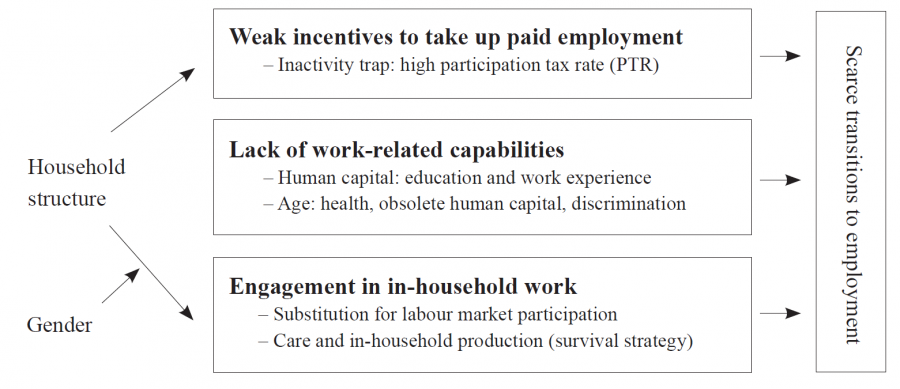
Authors, adapted fromFernandez et al. (2016).
3 DATA AND ANALYTICAL APPROACH
In this paper, we are pioneering the empirical evidence on welfare-to-employment transitions in Croatia in an effort to identify the dynamics and patterns of the exits of benefit recipients to employment status. For this purpose, with the consent of the Ministry of Social Welfare, we collected data on all the unemployed persons who were granted GMB in 2015 in one Croatian Centre for Social Welfare5, and then followed their status up until June 2017.
An anonymised dataset was created using the digital social welfare register (Soc-Skrb) data containing information on household benefit level, beginning and end of benefit usage. For each member of those households, we collected information on age, gender, settlement, prior recipient status, grounds for admission into beneficiary status. SocSkrb data was supplemented by additional information from the centre’s case record: prior employment experience, grounds for cessation of beneficiary status6, education level and field, amount of debt and duration of unemployment prior to being granted GMB, level of GMB and other benefits, as well as wage for those who made the transition. Also, we generated householdlevel attributes (household type: single, single-parent, several adults without dependents, several adults with dependents; presence of nursery age children). For each household, a PTR for taking up a minimum-wage job (HRK 2,496) was calculated, taking into account their given level and structure of benefits.
We have tracked all the sampled households from January 2015 (or the month when they were first granted GMB in 2015) all the way to June 2017. Thus episodes were created containing duration, outcome, episode-specific (e.g. level of GMB) and person-specific (e.g. gender) data. Most households had one episode of GMB on record, but some had several. Also, changes in composition of households (e.g. a person moving out of the household or a dependent child becoming unemployed) were accounted for. In cases where the status of unemployed GMB recipients had not changed for some members of the household (e.g. one household member had lost the GMB benefit – warranting a new administrative act and formal episode), adjacent episodes for those members were merged in one continuous spell.
During 2015, a total of 142 households with unemployed members were granted GMB; in all, there were 344 beneficiaries7. Over the observed 30 month period, a total of 208 individuals from those new households were classified as unemployed GMB recipients for at least a month8, for a total of 239 episodes of unemployment. Four persons who turned 18 or 65 during the period were excluded from the analysis.
Data was analysed using the event history (also known as survival analysis) approach, with general employment dynamics being described by estimation of Kaplan-Meier failure function, and differences of failure functions between groups being tested with log-rank test. For the multivariate framework exploring contribution of covariates associated with the aforementioned mechanisms, we have applied Cox proportional hazards regression model (Box-Steffensmeier and Jones, 2004; Cleves, Gould and Marchenko, 2016) with shared frailty at the level of individuals.
4 RESULTS
4. 1 STRUCTURE OF NEW GMB BENEFICIARIES
Before venturing forth with outcomes, we will describe the structure of our GMB cohort(cf. table A1 for source data on structure, estimated PTR and employment outcomes within 12 months for each category).
Starting with characteristics likely to affect incentives to work, unemployed GMB beneficiaries are heterogeneous with respect to the total level of GMB-related benefits their household receives (graph 3, upper pane), interdecile range stretching from HRK 1,000 to HRK 2,040, yet the modal value received by 29% of beneficiaries being exactly HRK 1,000 (single household benefit with electricity supplement). When child benefits are added, the distribution widens towards HRK 1,000 to HRK 3,518, and the average total of household benefits increases from HRK 1,388 to HRK 1,781 (graph 3, lower pane). More than half of GMB beneficiaries had their bank accounts blocked due to indebtedness, and 42% were under debt execution/repossession orders exceeding two minimum wages.
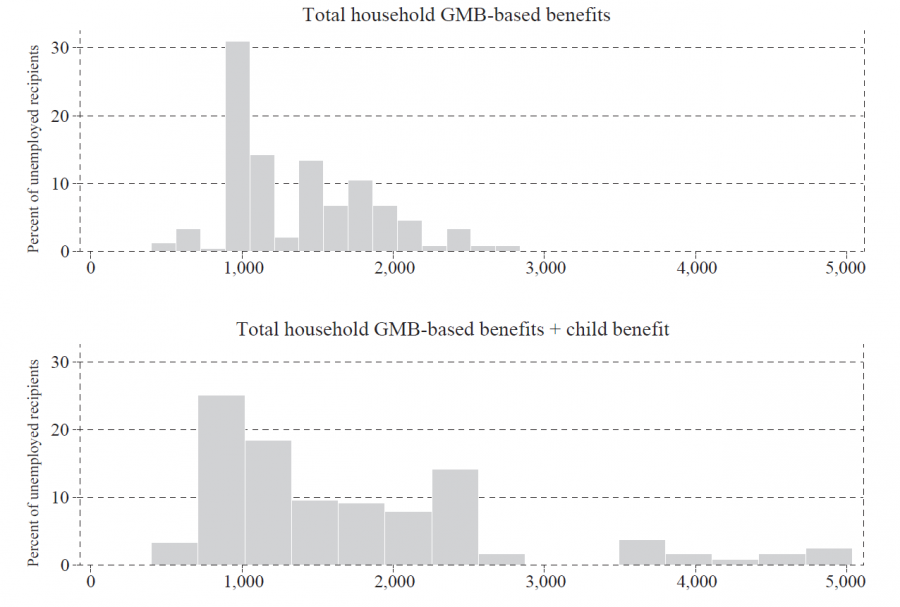
SocSkrb, calculation of the authors.
With respect to the household structure, about half of the new beneficiaries belong to household types supposedly characterised by the inactivity trap: single-parent households and households with two or more adults with dependents9. Yet about a third of new unemployed GMB beneficiaries resided in a single-person household, and about one fifth recipients were living in a multiple-person household without dependants10, supposedly facing considerably lower PTR as barrier to employment. However, the average calculated PTR for taking up a minimumwage job based on household structure and benefit levels of cohort observed resulted in PTR estimates within a 9 percentage point range: the lowest for singleperson household (52%), and the highest for household with dependants (61% – yet much lower than 102% in TBID). Therefore, we will turn our analytical focus toward the calculated level of PTR as a direct indicator of work disincentive.
We have calculated average PTR for taking a minimum wage job for unemployed GMB recipients that we have tracked at 57%. For about three quarters of them minimum wage PTR stands between 50% and 70%, with modal bin about 50% (graph 4). A minimum wage PTR lower than 40% is mostly observed for large families with large child benefits, or small households where not all members qualify for GMB. High minimum wage PTR is to be found among households with GMB-based benefits close to the minimum wage (coupled with housing and electricity supplement), while receiving no or limited child benefits. However, in no case in our cohort did PTR for taking up a minimum wage job exceed 90%.
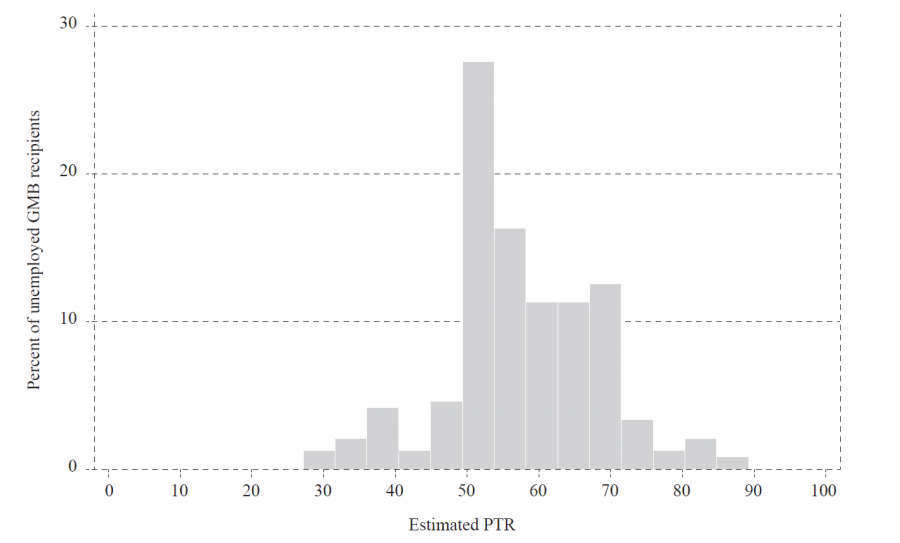
SocSkrb, calculation of the authors.
As for work-related capabilities, the majority of newly unemployed GMB recipients (56%) had just compulsory education or no education, 43% had secondary education and 1% had tertiary education. The educational structure of the tracked GMB cohort is roughly similar to that of all the GMB beneficiaries of the Centre for Social Welfare, about one fifth had no prior employment experience whatsoever, and similar share had more than ten years of tenure, while the majority of unemployed beneficiaries had a modest amount of employment experience.
The age structure of new GMB recipients is diverse, with most beneficiaries in the 30-50 age group, trailed by the 50-64 group. Slightly more than half of new beneficiaries were at least once registered as GMB beneficiaries prior to 2015 and were effectively returning to GMB. About one fifth were long-term unemployed by the time GMB kicked in.
With respect to households more inclined to in-household work, altogether 48% of recipients lived with frail or underage dependants in the household, and 15% had nursery-aged children (0-3). Our tracked cohort has characteristics very similar to those of general GMB beneficiaries within Požega Centre regarding gender ratio. While men are somewhat overrepresented (57%) among newly unemployed GMB beneficiaries and in particular among single-person households (75%), women account for the majority (85%) of single-parent recipients.
4. 2 TRANSITIONS TO EMPLOYMENT
About 43% of tracked episodes had not been completed by the end of the observation period, while other users had made the transition out of GMB status (table 1). A GMB episode most often ended due to the employment of recipient (22.3% out of whom 2.6% were still receiving GMB after employment) or employment of another household member (13.5%). About 18% of episodes ceased due to other reasons: in 4.7% episodes, beneficiaries were sanctioned due to inactivity (leaving the unemployment register leads to withdrawal of benefits), and in 4.3% due to excessive household income.
Source: SocSkrb, calculation of the authors.
Such distribution of outcomes, with varying time windows of observation, limited number of participants and a lot of censoring due to the employment of other household members led to a choice survival analysis framework, with transition to employment being observed as a relevant event. The Kaplan-Meier estimate of failure function indicates that about 24% of unemployed GMB recipients found a job within one year of entering GMB (graph 5).
This is significantly less than 55% of employed within 12 months among all who entered unemployment in the 2012-2014 period (Lucić, forthcoming). Within two years, the share had increased to 34%, indicating a decline of the hazard rate for transition towards employment, yet no isolation from the labour market11. However, when the employment of any household member is observed as an outcome (effectively ending the GMB episode), then transitions stand at 36% within a year and 47% within two years.
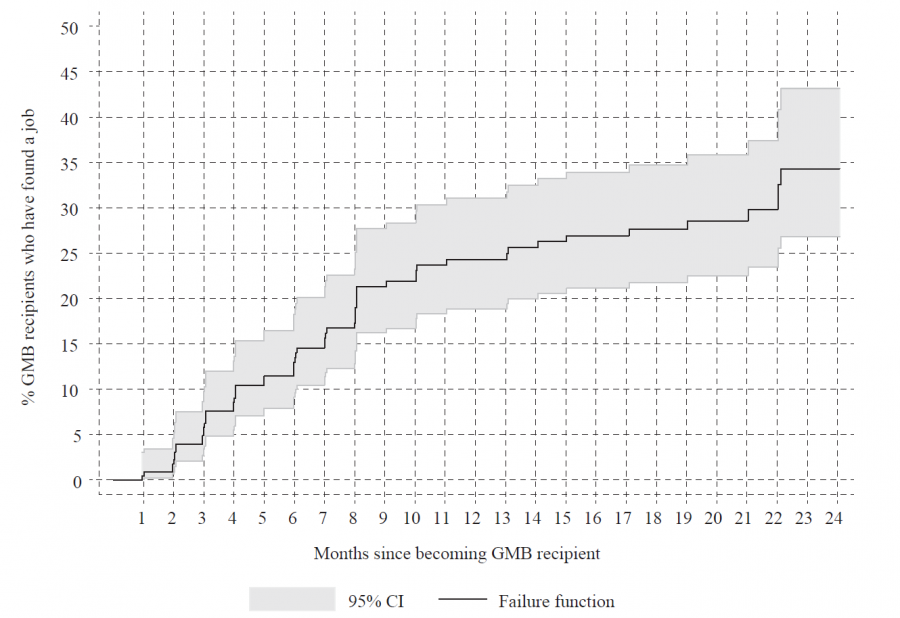
Source: SocSkrb, calculation of the authors.
Moving on to exploration of the role of employment barriers, we start with criteria indicating lack of incentives to work. However, with the observed cohort of GMB recipients, we fail to observe a consistent association between either PTR, benefit level (GMB-related benefits only, or coupled with child benefits) or indebtedness and transitions to employment. That is, unemployed GMB recipients with a higher level of benefits, deeper in a debt spiral or those who would be exposed to higher PTR if getting into a job are not less (or more) likely to find a job than others (graph 6). The only criteria where diverging outcomes were identified is total benefit level – with beneficiaries from two middle income groups underperforming (HRK 1,160 – 1,400) or overperforming (HRK 1,560 – 2,350) respectively. Such observations do not conform to the patterns that would be expected if lack of incentives due to inactivity trap were the prevailing mechanism at work.
Descriptive evidence is stronger with respect to the lack of work-related capabilities acting as a barrier (graph 7). Formal education level is associated with employment outcomes among GMB recipients. The few beneficiaries with tertiary education had bounced back into employment quickly. Among other, more prevalent, groups, there is an advantage for persons who have completed short vocational education programmes (such as waiters, cooks, electricians, hairdressers, salespersons, etc.), with about 40% getting a job within a year. On the other hand, less than one fifth of beneficiaries with no upper secondary education got employed within a year. Yet unlike studies following the general population, outcomes of beneficiaries with four-year upper secondary education (technical or general) are no better than for those with no upper secondary education. Yet, observed outcomes for GMB recipients for any given level of education are substantially weaker than those demonstrated at the national level for persons entering unemployment in the 2012-2014 period (Lucić, forthcoming).
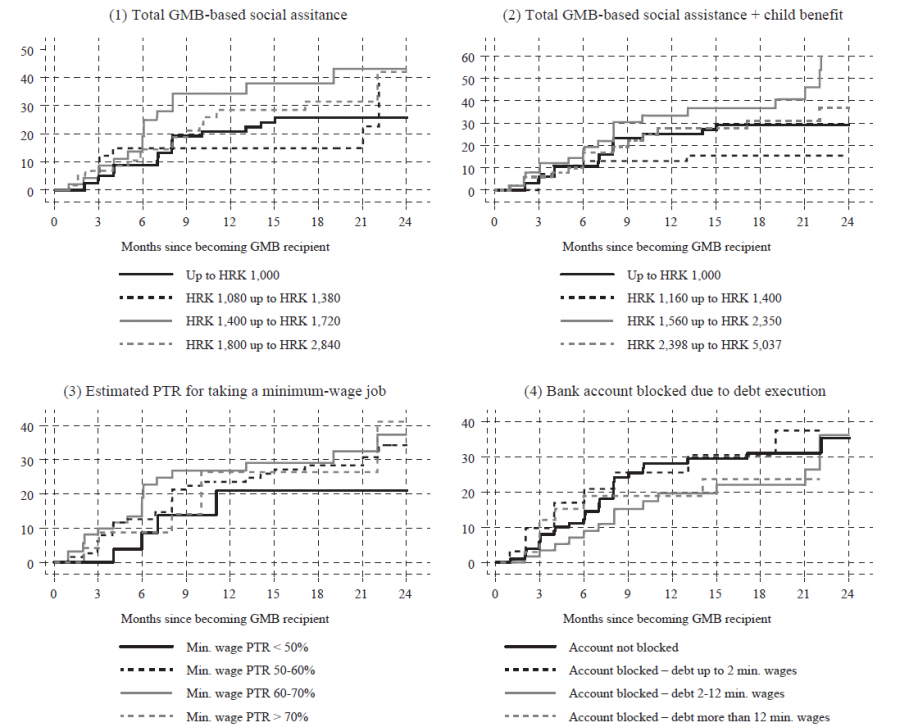
Log-rank tests: (1) chi2(3)=3.67; (2) chi2(3)=8.38*; (3) chi2(3)=0.98; (4) chi2(3)=2.10. Source: SocSkrb, calculation of the authors.
There is some evidence for the importance of work experience for the employment of GMB recipients. The association, however noisy, broadly fits the commonly found inverse U pattern: those with no prior employment experience and those with more than 10 years having a weaker chance for employment. Failure functions with respect to age demonstrate a well-established age effect: only 10 per cent of recipients older than 50 got employed within one year (cf. 37% in the general population of the unemployed), but no distinction in employment transitions is to be found for persons 30-50 and those under 30. So far, at the descriptive level employment patterns of unemployed GMB recipients seem to be in line with the human capital framework – patterns for education, tenure and age being consistent in direction but subdued compared to those observed for the general population (Bezeredi and Urban, 2016;Lucić, forthcoming).
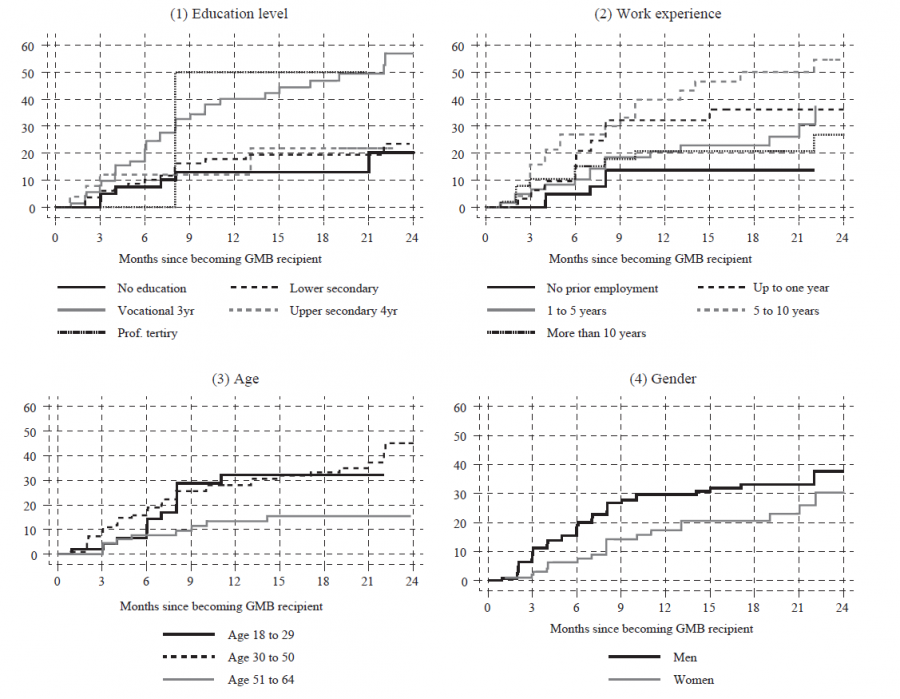
Log-rank tests: (1) chi2(4)=17.46**; (2) chi2(4)=12.12*; (3) chi2(2)=5.37+; (4) chi2(1)=4.24*. Source: SocSkrb, calculation of the authors.
There is a substantial difference in transition dynamics with respect to gender, with almost twice as many men than women finding a job within a year from entering GMB (but with indication of convergence later on). However, such a difference is not found among the general unemployed population (cf.Lucić, forthcoming), and merits exploration of the gender-specific effect of household structure.
Employment of men and women in GMB follows different patterns, depending on household type and their family role (graph 8). Male GMB recipients are more likely to make the transition to employment when there are dependants in the household. It is exactly these configurations in which female GMB recipients have very weak chances for employment during first twelve months. Yet female employment performance is similar to that of men when there are no other dependants in the household. Such patterns are in line with traditional gendered specialisation within the family, and the substitution of in-household work for labour supply for unemployed female GMB recipients, consistent with care responsibility hypothesis.
The descriptive findings are broadly confirmed with the Cox proportional hazard model (table A2 in appendix). The model simultaneously includes variables corresponding to all three barriers, albeit some in reduced (dichotomized) form due to the limited number of observations. We have introduced both PTR and total household benefit level simultaneously in order to distinguish the effect of total available resources from non-labour income with the inactivity trap due to potential taxation of labour income. Interaction of gender with household structure and the presence of a nursery-age child was introduced to account for the genderspecific substitution of in-household work for labour income. The proportional hazard assumption was tested using Schoenfeld residuals on the fitted model, proving satisfactory in general, apart for the gender/single parent household interaction (rho -0.24, p<0.1) and total benefit level (rho -0.23, p<0.05).
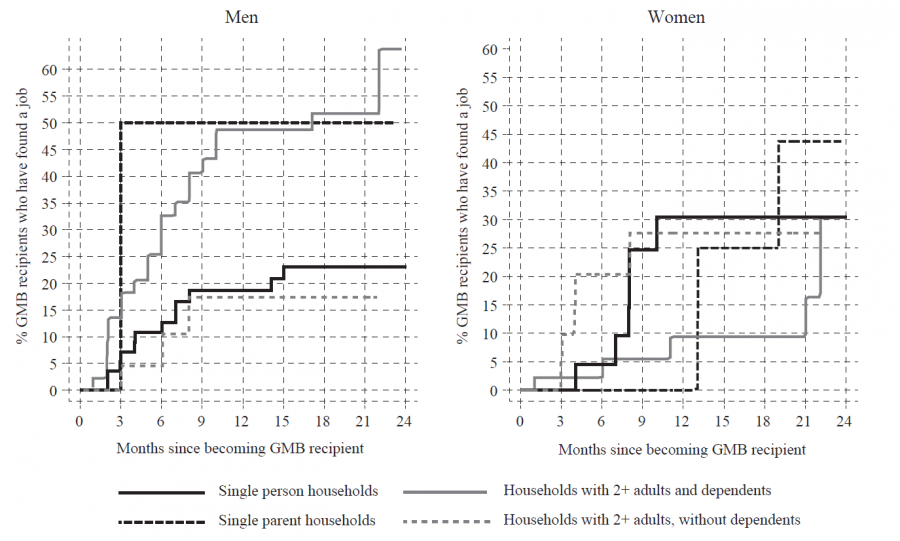
Log-rank tests: (Men): chi2(3)=12.09**; (Women): LR test chi2(3)=3.67. Source: SocSkrb, calculation of the authors.
Starting with work-based capacities, in the multivariate model, advanced age still seems to be hindrance for both men and women, net of human capital. Vocational education and to lesser extent prior employment experience contribute to transition to employment, implying the role of (lack of) capabilities. Notably, duration of unemployment prior to entering GMB status and history of using GMB do not hinder transitions to unemployment.
With respect to disincentives to work, no linear contribution of benefit level, PTR for getting a minimum-wage job, or existence of substantive debt was identified in terms of transition to employment.
With respect to household work substitution, no effect was identified for household configuration per se. Other things being equal, women who receive GMB seem to be less likely to make the transition to employment than men, yet this seems not to be the case when there are no dependants to care for, or for women in single-person households. No additional effect was identified when a child was present in the household.
4. 3 WAGES, ASSUMED AND REALIZED PARTICIPATION TAX RATE OF GMB RECIPIENTS WHO FOUND A JOB
The information accessed through SocSkrb system during the process of GMB administration allows for detailed information on benefits of household members, as well as wages of beneficiaries that managed to find a job. In 58% of cases, achieved wage was higher than 110% of the 2016 statutory net minimum wage (HRK 2,496), in 44% of cases higher than 125% of statutory wage, and in 12% of cases higher than 150% of minimum wage, the highest on record being 2.2 times higher than minimum wage, although still lower than the average wage level (graph 9). However indicative, this is not representative of the earning potential of GMB recipients in general, as those who failed to find a job might have had even less capacities – and worse opportunities (cf.Bezeredi and Urban, 2016). While an extension of this research might lead to estimation of potential wages, the dana at hand can be used to calculate actual PTR for those GMB recipients who did find a job. The spread of actual PTR for those who made the transition was rather broad (table 2): from 31% to 96%, standing at an average 53%. Average realized PTR was somewhat higher for households with dependants (58%), and about 50-55% for other household types. It is worth mentioning that for any given household type, the average realized PTR was slightly lower than one hypothesised under the minimum wage assumption – as in many cases wages turned out to be higher than minimal.
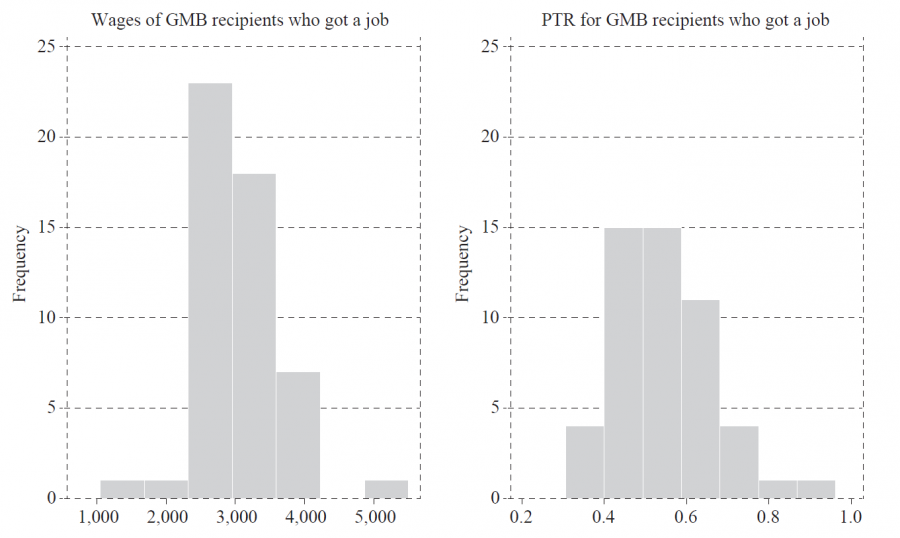
Source: SocSkrb, calculation of the authors.
Source: SocSkrb, calculation of the authors.
4. 4 RELAPSE INTO SOCIAL ASSISTANCE
Transition into employment itself does not guarantee stable labour market attachment. Successful activation should lead to stable employment, but the same set of barriers might push the vulnerable part of the population back into the social assistance system. Therefore, relapse into social assistance was another outcome that we have observed within the survival analysis framework, although only for the 58 GMB recipients who did manage to get a job, and for a considerably shorter period of observation. About a quarter of GMB recipients who got into employment had relapsed into GMB within 12 months from employment (graph 10).
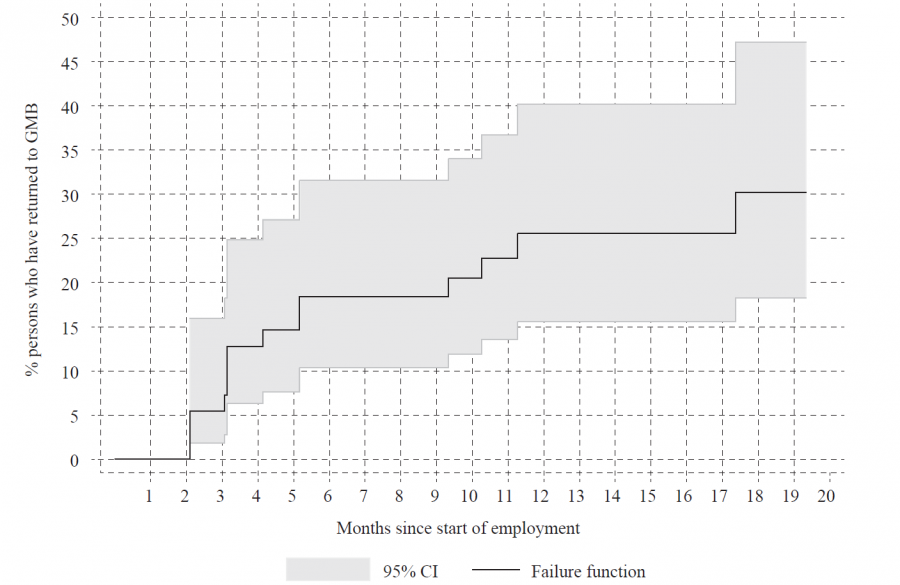
Source: SocSkrb, calculation of the authors.
While the number of observations was insufficient for application of more sophisticated model, we have compared patterns of relapse with respect to gender and effective PTR of employment (based on wage and prior benefit level). It seems that women are more likely to relapse into GMB than men, while persons who faced above-average PTR when entering employment (for whom work paid off to lesser extent) were less likely to return to GMB (graph 11). This warrants more research.
5 CONCLUSION
In this small-scale analysis based on a rich collection of data used in the administration of social assistance, we have managed to show that transitions from GMB to employment do happen, but are far from commonplace. In the case of this particular centre for social welfare, about one quarter of unemployed persons who were granted GMB got into employment within a year, in most cases for wages less than 150% of the statutory minimum wage, and about one quarter of those who got employed returned to GMB within another year.
While the population of GMB recipients is quite heterogeneous, the majority has failed to complete upper secondary education, and a substantial share has advanced age, no work experience, or are living in large households burdened with family responsibilities. Being exposed to strict means testing, their financial resources are very limited (or even negative due to debt) and they face withdrawal of most benefits as soon as they get into employment. For this reason, we set about examining the role of three distinct barriers to employment: lack of work-related capabilities, lack of incentives to work and the substitution of in-household labour.
Our analysis suggests that transition to work varies greatly due to individual employability and the gender-household configuration nexus. In terms of work-based capabilities, findings are consistent with prior research with the general population or unemployed in Croatia (Šverko et al., 2006;Botrić, 2009;Matković, 2011;Bezeredi and Urban, 2016;Lucić, forthcoming). Namely, GMB recipients with vocational education make the transition to employment about twice as often as others, confirming the key role of education, while differences due to tenure and age are consistent in direction but their effect is subdued compared to those observed for the unemployed in general (Bezeredi and Urban, 2016;Lucić,forthcoming). As for disincentives to work, we found that individually calculated PTR for finding a minimum-wage job to be a substantial 57% on average, but more compressed (interquartile range 50-60%), and less divergent with respect to household types than established for hypothetical households (e.g.Bejaković, Urban and Bezeredi, 2013). However, we found no conclusive evidence that level of minimum-wage PTR, total level of household benefits, or indebtedness are associated with transition to employment. Possibly the incentives for job search due to low benefit level might have been negated by the negative effect of financial hardship towards finding a job (Šverko et al., ref1798#2006;Galić, 2011). As for substitution of in-household work as survival strategy and answer to care responsibilities, we found no evidence of single-person households having better access to labour market, but female GMB recipients are less likely to find a job if they live in households with partner and dependants.
Our findings are best taken as provisional proof of the concept, as the scope of our analysis has several shortcomings. First, it follows up only about one per cent of one year’s entrants into GMB in Croatia, all from the same region. Possible idiosyncrasies of social welfare centre or local (predominantly rural) community lead to caution in the generalisation of findings. Extending the scope of analysis to the entire country would not only provide a more sophisticated model and reliable estimates by increasing the sample by two degrees of magnitude, but would introduce enough variation to estimate the effect of job opportunities (another barrier in the WB conceptual framework) and role of other contextual variables. Second, as only new entrants into GMB were observed, and outcomes were traced for quite a short period (at most two and a half years), our findings extend only to “short-term” GMB beneficiaries. However, by the end of 2015, 72% of beneficiaries in Croatia received GMB for more than one year and 26% for more than five years, making a strong case for an extension of the analysis of transitions and barriers to employment towards long-term GMB beneficiaries. Third, in all the cases where a household loses GMB status due to reasons other than the employment of the observed individual (e.g. employment of partner), our observations are effectively censored, and no information on subsequent employment for given individual was gathered under the current approach, probably resulting in an underestimation of transitions to employment.
Until such an extension is made, this analysis provides some circumstantial evidence in favour of activation interventions targeting all adults in beneficiary households, providing GMB beneficiaries vocational education and care services where needed in order to facilitate transitions to employment.

